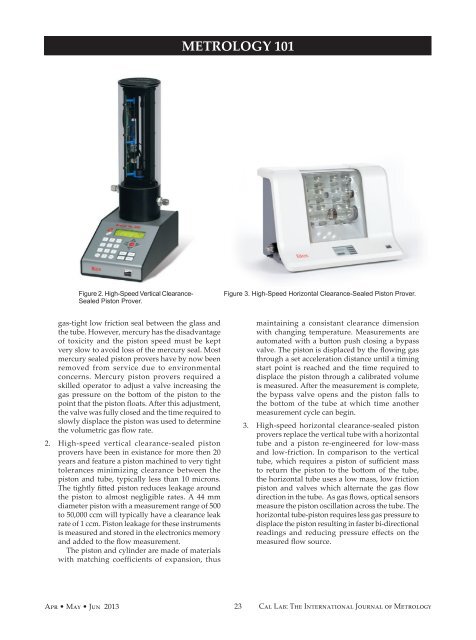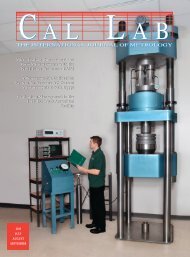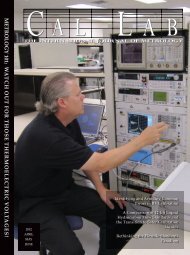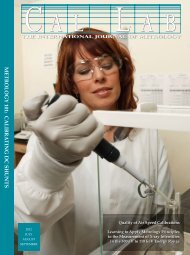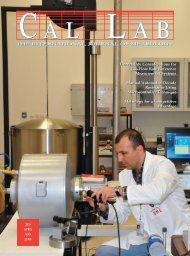METROLOGY 101: PISTON PROVER DESIGN - Cal Lab Magazine
METROLOGY 101: PISTON PROVER DESIGN - Cal Lab Magazine
METROLOGY 101: PISTON PROVER DESIGN - Cal Lab Magazine
You also want an ePaper? Increase the reach of your titles
YUMPU automatically turns print PDFs into web optimized ePapers that Google loves.
<strong>METROLOGY</strong> <strong>101</strong><br />
Figure 2. High-Speed Vertical Clearance-<br />
Sealed Piston Prover.<br />
Figure 3. High-Speed Horizontal Clearance-Sealed Piston Prover.<br />
gas-tight low friction seal between the glass and<br />
the tube. However, mercury has the disadvantage<br />
of toxicity and the piston speed must be kept<br />
very slow to avoid loss of the mercury seal. Most<br />
mercury sealed piston provers have by now been<br />
removed from service due to environmental<br />
concerns. Mercury piston provers required a<br />
skilled operator to adjust a valve increasing the<br />
gas pressure on the bottom of the piston to the<br />
point that the piston floats. After this adjustment,<br />
the valve was fully closed and the time required to<br />
slowly displace the piston was used to determine<br />
the volumetric gas flow rate.<br />
2. High-speed vertical clearance-sealed piston<br />
provers have been in existance for more then 20<br />
years and feature a piston machined to very tight<br />
tolerances minimizing clearance between the<br />
piston and tube, typically less than 10 microns.<br />
The tightly fitted piston reduces leakage around<br />
the piston to almost negligible rates. A 44 mm<br />
diameter piston with a measurement range of 500<br />
to 50,000 ccm will typically have a clearance leak<br />
rate of 1 ccm. Piston leakage for these instruments<br />
is measured and stored in the electronics memory<br />
and added to the flow measurement.<br />
The piston and cylinder are made of materials<br />
with matching coefficients of expansion, thus<br />
maintaining a consistant clearance dimension<br />
with changing temperature. Measurements are<br />
automated with a button push closing a bypass<br />
valve. The piston is displaced by the flowing gas<br />
through a set acceleration distance until a timing<br />
start point is reached and the time required to<br />
displace the piston through a calibrated volume<br />
is measured. After the measurement is complete,<br />
the bypass valve opens and the piston falls to<br />
the bottom of the tube at which time another<br />
measurement cycle can begin.<br />
3. High-speed horizontal clearance-sealed piston<br />
provers replace the vertical tube with a horizontal<br />
tube and a piston re-engineered for low-mass<br />
and low-friction. In comparison to the vertical<br />
tube, which requires a piston of sufficient mass<br />
to return the piston to the bottom of the tube,<br />
the horizontal tube uses a low mass, low friction<br />
piston and valves which alternate the gas flow<br />
direction in the tube. As gas flows, optical sensors<br />
measure the piston oscillation across the tube. The<br />
horizontal tube-piston requires less gas pressure to<br />
displace the piston resulting in faster bi-directional<br />
readings and reducing pressure effects on the<br />
measured flow source.<br />
Apr • May • Jun 2013<br />
23<br />
<strong>Cal</strong> <strong>Lab</strong>: The International Journal of Metrology


